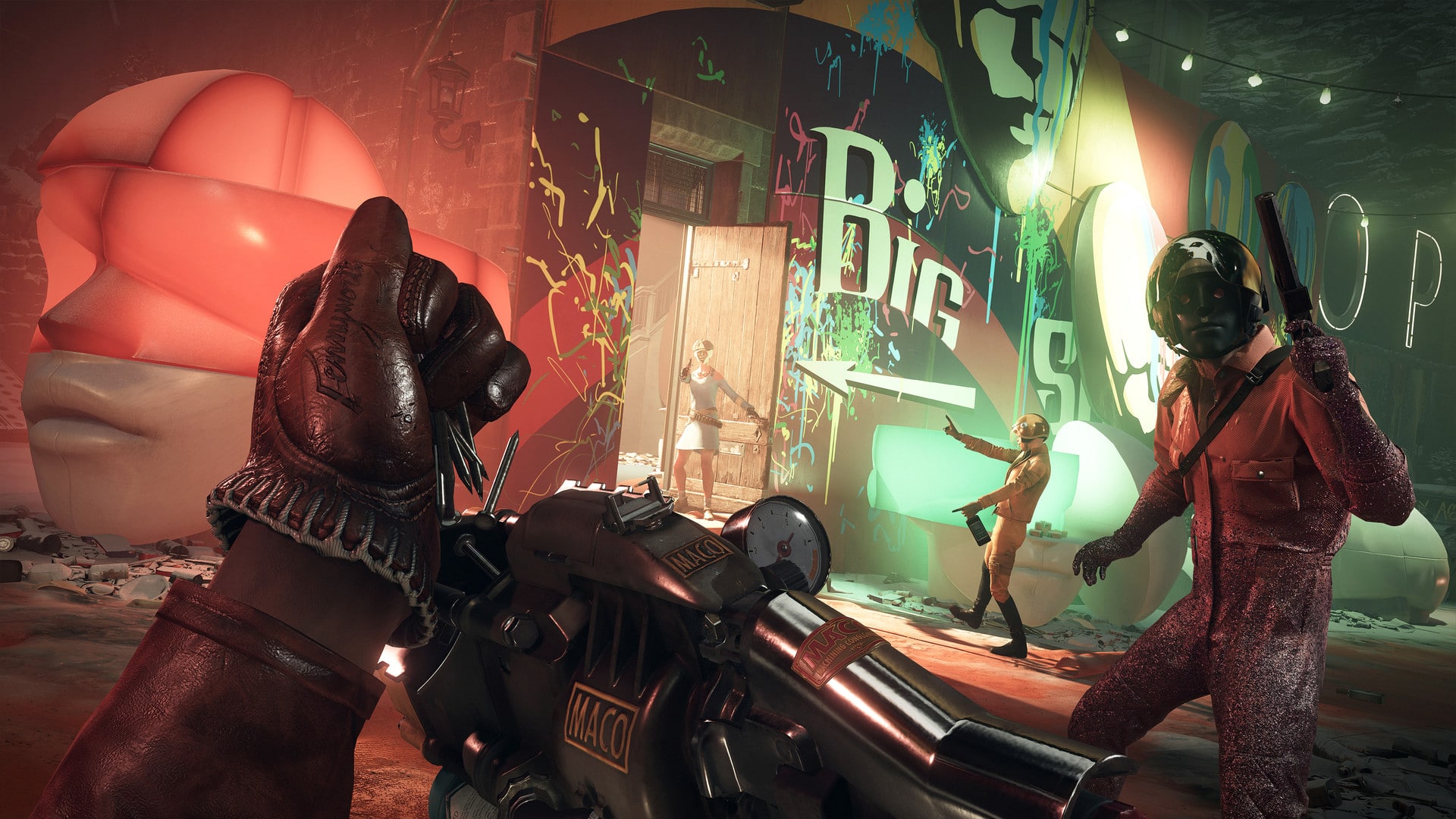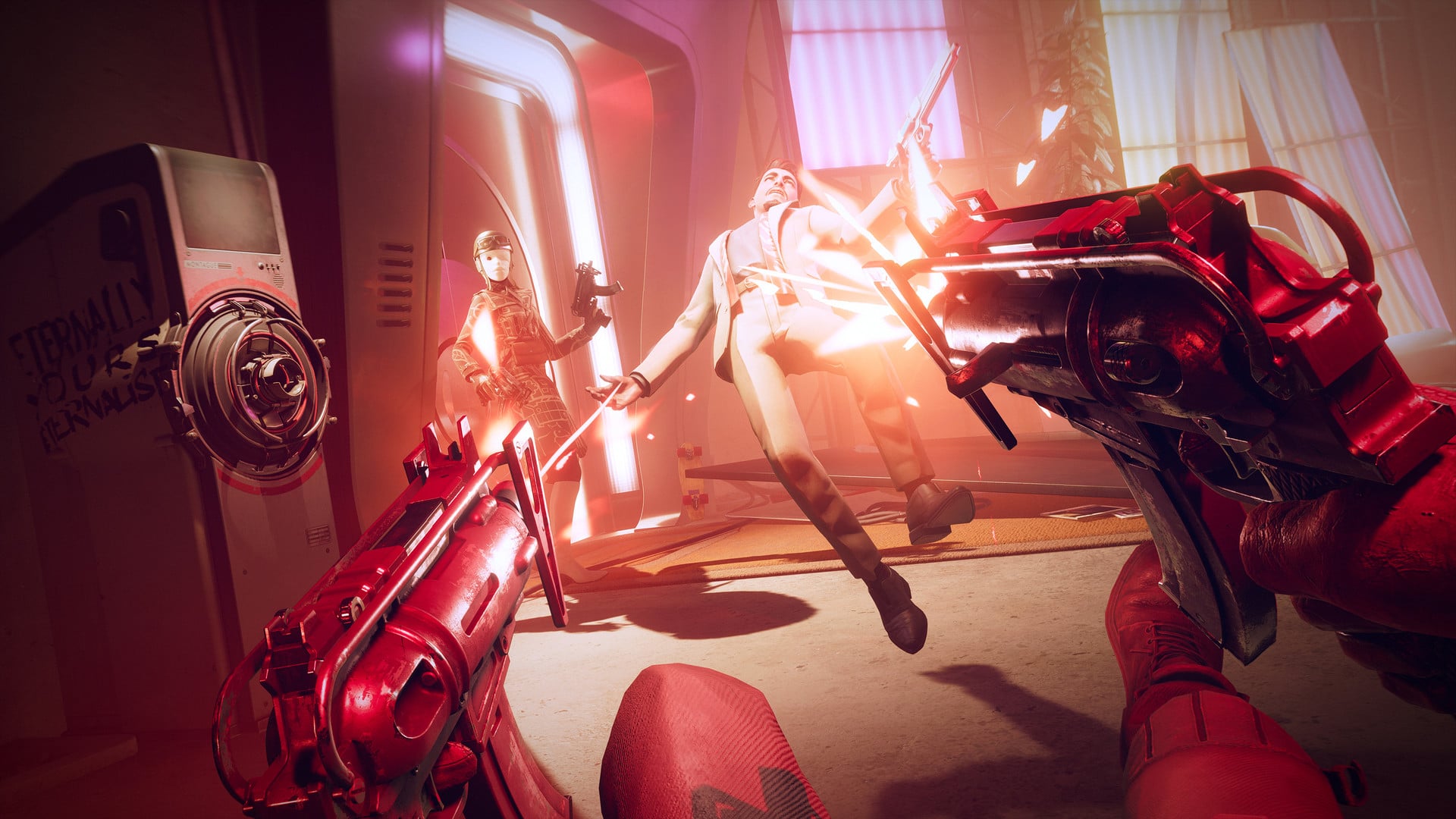If there is one thing you can always rely on with immersive sims like Deathloop, it’s the old Looking Glass passcode, a specific sequence of numbers that has appeared in myriad games dating back to System Shock. So when I run up to the first keypad-locked door in Deathloop and the game tells me, in its ever-present glowing script, “You already know the code!”, I smile with knowing self-satisfaction. Of course I know the code, I think to myself smugly — I’ve been playing these sorts of games for over 20 years. I punch in “0451.” The door does not open. The knowing smile turns to a puzzled grimace. Then the game hands out an achievement: “Old Habits Die Hard.”
It’s the first of many moments that tell you Deathloop both is and isn’t like Arkane Studios’ previous games and, by extension, both is and isn’t like the games Arkane took inspiration from: Ultima Underworld, Thief, System Shock, and Deus Ex. Deathloop embraces some of the high points of the immersive sim design philosophy — the intricate levels and systems that encourage a choice of approach and generate complex gameplay situations out of more basic building blocks. But it mixes this philosophy with as many other influences: the kick from Dark Messiah of Might & Magic, the fast-paced gunplay from the Wolfenstein reboot, the set piece opportunities from Hitman, the time loop mechanics that have become so popular in the last few years.
The fact that Deathloop is up front about its subversion of immersive sim expectations frees it to pick and choose from those expectations. Ask a purist about the “right” way to play Thief and they will tell you that it’s to stealth through the entire game without killing anyone and to pick up all of the loot, even if that involves ignoring the core objectives. Since loot is often squirreled away in obscure nooks and crannies, it can also involve a lot of backtracking.

That sense of completionism has carried over into every immersive sim I’ve played since Thief. I’ve combed through every level in Dishonored and its sequels not only for the obvious runes, bone charms, paintings, and blueprints, but its coins and written notes. I’ve burglarized every flat in Deus Ex: Human Revolution and Deus Ex: Mankind Divided. I’ve spent more time reading emails in Prey than I have reading my own emails.
It’s a compulsion I think is born of a fear of missing out. Immersive sims have some of the best level design in the medium, and I worry that I will miss some particularly impressive piece of design if I do not scour every area. But it’s a compulsion that can make for some slow and plodding gameplay. Dispatching a building full of Dishonored’s Overseers with a mix of deft navigation and clever powers feels somehow in tension with spending 10 minutes wandering around the same building poking into and around every cupboard for loose change.
Deathloop does not have this problem. Almost as soon as it has told you that the old 0451 trick won’t work, it tells you not to worry about exploring each level in a single run. The game is structured around four times of day — morning, noon, afternoon, and evening — and a time loop that goes back to the morning at the end of the day. While the game’s four districts have different enemy placements and opportunities at different times of day, and the overall aim is to figure out how to line these up in such a way as to kill eight key targets in a single loop, there is potentially an infinite number of loops to try. As such, there is little incentive to explore an entire level in a given loop, and instead the focus is on pursuing a particular objective within a discrete part of the level. It helps to keep the pacing fast and the levels from getting stale.

At the same time, there is still an incentive to collect everything. You need gear and information gathered from different districts at different times to open up opportunities to collect more gear and information, and you need all of this to get to your eight targets. The difference to something like Thief or Dishonored is just that, instead of collecting everything in one long playthrough of a level, you build a kind of composite picture of the game’s levels over multiple, usually quick runs — your choice of destination a function not only of spatial map markers, but also the time of day.
The approach is not seamless. The compulsion to slow down and explore in Deathloop’s ancestors, for all the pacing issues it raises, also lends itself to deeper environmental storytelling. In Deux Ex, for example, you might wonder what a set of binoculars placed on the edge of a balcony says about their owner or about the apartment they are facing. In Deathloop, you probably wouldn’t even notice them.
Similarly, there is a sense of rich, brooding atmosphere that I think comes, in some intangible way, from the desire to slow down and absorb your surroundings. The meticulously modeled and arranged clutter of the worlds in Deus Ex, Dishonored, Prey, and others invite attention and contemplation. Deathloop is an extravagantly stylish game with a welcome tongue-in-cheek light-heartedness and a rocking soundtrack that is rare for the immersive sim genre. Its style supports its quick pacing, but it also loses something of that intangible atmosphere in the process. The levels are cleverly designed, but it’s as if their fragmentation into smaller spaces and quicker runs saps some of that atmosphere.

Nor does the time loop mechanic completely sidestep the pacing issue. Later in the game, as I started to run out of information to extract from each loop, certain levels at certain times of day would present almost no new opportunities, resulting in some lengthy runs for little gain. Either that or I would spend a little too long in Deathloop’s board game-like menus, fast-forwarding time to get to the right period.
Just as with everything else then, the approach to completionism in Deathloop both is and isn’t like those of the immersive sims it takes inspiration from. It’s liberating not to feel like you have to comb through an entire level in a given run, and it does wonders for the pace of the gameplay. On the other hand, a lot of the downtime is shunted into Deathloop’s meta-game of gathering gear and information. It may be an effective solution, but it comes close to removing something of what made Arkane’s games engrossing to begin with.





